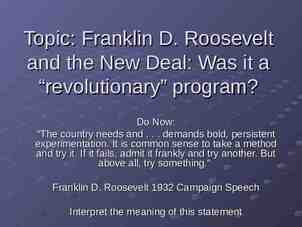International Money & Finance Chapter 12: Determinants of the
36 Slides1.03 MB
International Money & Finance Chapter 12: Determinants of the Balance of Trade Michael Melvin and Stefan Norrbin
Outline of this Chapter The chapter tries to explain why the domestic currency devaluation does not necessarily improve the balance of trade. Elasticities Approach J-Curve Currency Contract Period Pass-Through Analysis The Marshall-Lerner Condition Absorption Approach
Explaining the Balance of Trade with Theories The balance of trade records a country’s trade in goods and services with the rest of the world. Why do some countries run a balance of trade surplus, while others run deficits? We try to explain this question using 2 approaches. Elasticity Approach Absorption Approach
Trade and foreign exchange When a country imports, it supplies foreign exchange as payment. When a country exports, it demands foreign exchange as payment. An excess supply of foreign exchange is equivalent to a balance of trade deficit. An excess demand for foreign exchange is equivalent to a balance of trade surplus. The balance of trade is in balance when the quantity of foreign exchange supplied and quantity demanded are equal.
Using the trade flow model to explain the devaluation / S1 (UK importers) S2 Assume that the U.K. taste for U.S. goods rises. The pound should depreciate. 2.00 The D intervention Q1 QS Q An increase in the demand for U.S. goods by the British. The more they import, the more they supply the British pound. Bank of England can peg the exchange rate at 2.00/pound by selling and buying pound by the amount QS - Q1 . U.K. balance of trade: Exports same as before Imports increase Thus, U.K will have a trade deficit at a pegged exchange rate.
Using the trade flow model to explain the devaluation / S1 (UK importers) S2 2.00 1.00 D 1 Q Q2 Q How to eliminate trade deficit? The Bank of England could devalue the exchange rate from 2/pound to 1/pound. This would make the U.S. goods become more expensive for the British. So it should slow down the imports from the U.S. and improve trade balance again.
Puzzle: sometimes trade deficits become worsen after the devaluation A devaluation of domestic currency price of domestic exports export more price of foreign imports import less Trade deficit should improve. However, it doesn’t always work like this in the real world. In many case, trade deficits become worse after the devaluation. Why?
Elasticities Approach to the Balance of Trade The Elasticities Approach is concerned with how change in relative prices of domestic and foreign goods will change the quantities traded. Relative price – the price of one good relative to another. Relative prices change as relative demand and supply for individual goods change (caused by changes in taste, production technology, or government taxes/subsidies, etc.) Ex: some medical research have found that eating chocolate everyday could reduce the risk of heart attacks. This event would increase the demand for chocolate and raise the price of chocolate. Holding other things constant, now the chocolate is relatively more expensive.
Elasticities Approach to the Balance of Trade: Exchange Rate and Relative Price A change in the exchange rate could change the price of foreign goods in terms of domestic currency. Example: Suppose that a tuxedo costs 100 in the U.S. and 100 in Italy. If the exchange rate is 1 1, then the tux costs the same in each country. If the exchange rate changes to 2 1, then For Americans: the tux in the U.S. is still 100, but the tux in Italy is now only 50 (half-off). For Italians: the tux in Italy is still 100, but the tux in the U.S. is now 200 (twice more). When appreciates ( depreciates): Americans find the Italian goods relatively cheaper. Italians find the American goods relatively more expensive. Would it mean that the U.S. will have the balance of trade deficit and Italy will have the balance of trade surplus?
Elasticities Approach to the Balance of Trade: Elasticities How much would the devaluation of the euro affect the U.S. quantity demanded for Italian goods depending on the elasticities of demand and supply. Elasticity – the responsiveness of quantity to changes in price. Inelastic: the quantity is relatively less responsive to price changes. Elastic: a small change in price causes a large change in the quantity. The elasticity of demand, , is The percentage change in quantity demanded divided by the percentage change in price.
Review the concept of elasticity From Note that we only consider the absolute value of this coefficient. If the price increase 5% and the quantity demanded fall by 5%, the elasticity of demand is 1. If is greater than 1, the demand is elastic. If is less than 1, the demand is inelastic. Just as we compute for , we can use the same formula to compute the elasticity of supply, . If the price increase 5% and the quantity supplied increase by 5%, 1. If is greater than 1, the supply is elastic. If is less than 1, the supply is inelastic.
Review the concept of elasticity P D inelastic Medicine Gasoline Smoking Coffee Few or no substitutes in the short run Many Substitutes in the short run Clothing Bakery products Carrying goods D elastic 4.00 2.00 Some substitutes in the short run pencil D normal soda pizza Q1 QN QE When price falls: A perfectly elastic demand, there is no change in the quantity. An elastic demand (flat), larger increase in Q. A inelastic demand (steep), smaller increase in Q. Q
Elasticity of Demand and Revenues Total revenue price x quantity Price Price P2 B P2 10% A Demand P1 B 10% P1 A More than 10% 0 Q2 Q1 Quantity When the demand is elastic, an increase in price will decrease the total revenue. 0 Q2 Q1 Demand Quantity When the demand is inelastic, an increase in price will increase the total revenue.
The devaluation and the J-curve Current Account J-Curve 0 Time devalue After the devaluation, it is often observed that the trade balance initially deteriorates for a while before getting improved. The pattern of the BOT after the devaluation creates a J-curve.
Why do we have a J-curve? J-curve effect – following a devaluation, trade balance is initially worsened before improving later. Two reasons to explain the downward part of the J-curve: The currency contracting period Immediately after the devaluation, trade and payments contracts have already been negotiated prior to the change in exchange rate become revalued. The pass-through period After the devaluation, import prices and export prices do not adjust as expected due to inelastic demand and/or supply curves.
Currency Contracting Period Contracts are usually set up for 30, 60, and 90 day payments and delivery. Immediately after a devaluation, contracts negotiated prior the exchange rate change become due Contracts signed t1 Currency devaluation t2 Payments due t3 time Contracts are signed at t1. A currency devaluation at t2. Payments have to be made at t3. In this case, the buyers and sellers have little ability to respond to the devaluation (inelastic). No change in quantity after the devaluation.
Example: Currency Contracting Effect Suppose that we import a BMW and agree to make a payment in 90 days for 20,000. Assume that S / 1.0 We are expecting to pay 20,000 for this imported car. Now, suppose that the dollar is devalued: S / 2.0 The effect of the devaluation depends on whether you agree on the contract to pay in dollars or in euros. If we agree to pay in euro, now the import cost goes up to 40,000. However, if we agree to pay in dollar in the contract, then the import cost remains the same at 20,000.
When dollar devalues: From S / 1.0 to S / 2.0 Import contract written in dollar: U.S. import values – unaffected. Import contract written in euro: U.S. import values – increase. (more expensive in the dollar term) Export contract written in dollar: U.S. export values – unaffected Export contract written in euro U.S. export value – increase. (get more dollars from the exported goods)
The effects on U.S. trade balance, after a dollar devaluation U.S. Import Contracts Written in Euro U.S. Export Contracts Written in Only Dollar U.S. exports U.S. import same Trade balance Euro U.S. exports U.S. imports Trade balance ? Dollar U.S. exports same U.S. exports same U.S. imports same U.S. imports Trade balance same Trade balance the quadrant 4 results in a deterioration of trade balance as depicted in the J-Curve. When import contracts are written in foreign currencies and the export contracts are written in the domestic currency, a domestic currency devaluation can lead to a trade deficit.
Pass-Through Analysis The contracting explanation applied for the duration of the negotiation period (i.e. 30, 60, or 90 days). What happens after that? After the contract expires, the quantity adjustment might still be minimal, if the good is inelastic or if suppliers cannot change the quantity supplied. Pass-through analysis consider the elasticity of demand and supply resulting in an inability for people to adjust in the short run. What happens if: Elasticity of demand for or supply of exports is inelastic. Elasticity of demand for or supply of imports is inelastic.
Example: suppose that dollar devalues by 10%. Case A: U.S. demand for imports is perfectly inelastic. A devaluation will increase the prices of imports in dollar. If imported goods are inelastic (e.g. hard to find a close substitute of French wine), U.S. importers will continue to buy at Q1. The supply curve shifts to the left. Foreign exporters want to charge a higher dollar price, because dollar is worth less. American buyers pay 10% more. Foreign exporters get the same in their currency. Import values: Original: P1 x Q1 New: P2 x Q1 Total import value
Example: suppose that dollar devalues by 10%. Case B: Foreigners’ demand for U.S. exports is perfectly inelastic. After the devaluation, the supply curve (by U.S. exporters) shifts to the right. U.S. exporters are willing to sell goods at lower price in foreign currency, because the foreign currency is now worth more. With the perfectly inelastic demand curve: The U.S. exports the same quantity American exporters charge lower price in foreign currency, but the value of exports in dollars remains the same. Total export value constant.
Example: suppose that dollar devalues by 10%. Case C: supply of foreign production is inelastic. The supply can be inelastic because the productions are constrained by labor/resources contracts, such that plants cannot expand or decrease the amount produced. Since dollar is weaken, foreign goods become relatively more expensive. The demand curve shifts to the left. The foreign currency price of imports falls by the amount of devaluation. Thus, there is no pass-through in this case (the price to foreigners does not change). The value of imports in dollars constant.
Example: suppose that dollar devalues by 10%. Case D: Supply of U.S. exports is perfectly inelastic A weaken dollar would increase the demand for U.S. exports. With the perfectly inelastic supply curve, the dollar price of exports rises by the full amount of the devaluation. As the price in dollar increases, the value of U.S. exports increases. Total export value increases.
U.S. Trade Balance Effects During Pass-Through Period (after the devaluation) Box 4 is the case where the U.S. trade balance get worsen, when both demands for U.S. imports and exports are perfectly inelastic.
Marshall – Lerner Condition Two economists have proven how high the elasticity has to be before a devaluation leads to an improvement of the balance of trade. Marshall – Lerner condition – the necessary condition of international demand elasticities that will ensure an improvement in the trade balance after a devaluation. Thus, the downward part of the J-curve represents the case that the sum of elasticities of demands for both imports and exports is less than 1. The Marshall-Lerner condition is not met. In the long run, we expect elasticities to increase. Therefore, the current account eventually improves.
Marshall-Lerner condition and the J-curve MLC: If the sum of elasticities of demand for imports and demand for exports is greater than 1, then trade balance will improve. J-curve indicates that when devaluation increases the price of foreign goods to the home country and decreases the price of domestic goods to foreign buyers, there is a short-run period during which trade balance falls.
Absorption Approach The elasticity approach shows that it is possible for a country to improve its trade balance by a devaluation. The devaluation will eventually reduce imports and increase exports, stimulating production of goods and services. What if a country is at its full-employment level of production before the devaluation, can it still improve trade balance? Sometimes the actual response of the trade balance to a devaluation seems slower than the elasticities approach would argue. Therefore, a different theory was developed that emphasized the aggregate output effect.
Absorption Approach Absorption approach to the balance of trade – a theory based on the relationship of domestic spending for domestic goods (absorption) relative to domestic output. From Macroeconomics, an economy’s total output (Y) is: Y C I G (X – M) C is consumption, I is investment, G is government spending, X is exports, and M is imports. Let us call (C I G) “Absorption (A)”: Y C I G (X – M) Domestic Net Exports Absorption (A)
Absorption Approach The absorption term represents the domestic spending by households, businesses, and government. Absorption: A C I G Y A X–M Y–A X–M If Y A X – M 0 (trade surplus) If Y A X – M 0 (trade deficit)
Absorption Approach and Trade Deficit Suppose that U.S. total output is 12 trillions and the absorption is 12.7 trillion. Y – A 12 – 12.7 - 0.7 trillion So, U.S. trade deficit would be 700 billion. How can we improve this trade deficit situation? Either Y or A A devaluation should improve balance of trade if we allow A or Y to adjust appropriately.
The effects of a devaluation Case 1: Y is below the full-employment level Y YF So, an economy still have some unemployed resources to be used in production. Thus, Y has room to increase. A devaluation leads to an increase in demand for the domestic goods and services, leading to an increase in the domestic production. Thus, the country can increase production without adjusting A. (Y – A) (X – M) Trade balance will improve, following a devaluation (after the elasticity period has gone by).
The effects of a devaluation Case 2: Y is at the full-employment level Y YF Then, we can no longer increase Y. Thus, A has to fall. How to decrease the absorption? A C I G C: by a consumption tax, by raising real interest rate, or by slowing down real wage growth. I: it is not a good idea to slow investment, as the long run growth of a country depends on investment, but need to make sure that there is not short run bubbles (e.g. dot-com markets in the 1990’s). G: this is the favorite place for a reduction. The IMF often recommends reductions here, e.g. Social Security Reform in Turkey to reduce the transfer payments by the government. Cutting farm and other firm subsidies is also a common target.
IMF and the Absorption Approach IMF provides financial assistance to a crisis-ridden country with some conditions to ensure debt repayment. (known as IMF conditionality). IMF usually requires the borrowing country to cut its absorption term. The conditions were aimed to promote the country’s long-run growth. However, they may have short-run costs to the borrowing country. Some economists criticize the conditions to cut the domestic absorption to do more harms than good and would send the country in a recession to more severe recession. There are still debate whether IMF conditionality is good or bad for countries.
Conclusions This chapter discussed why the domestic currency devaluation does not necessarily improve the balance of trade, especially in the short run. The elasticities approach to the balance of trade explains how various degrees of elasticities of demand and supply of imported goods could affect the balance of trade. A devaluation of the domestic currency raises the price of foreign goods relative to the domestic goods. As prices of imports increasing, the total payments to importers could rise or fall depending on the elasticities of demand for imports. The J-curve describes the pattern of the balance of trade after the currency devaluation such that the trade balance falls in the beginning and then rises later. The J-curve effect could be a result of currency contract period and pass-through price adjustment.
Conclusions Since some of international exchange contracts are signed before and the payments are collected after the currency devaluation, the devaluation could worsen the balance of trade when the export contracts are written in domestic currency and the import contracts are written in foreign currency. The balance of trade will worsen from a currency devaluation, if there is a full pass-through, resulting in higher import prices and lower export prices. The Marshall-Lerner condition indicates that if the sum of absolute values of the elasticities of demand for imports and demand for exports is greater than one, a currency devaluation could improve the balance of trade. According to the absorption approach, the effects of the currency devaluation on trade balance depend not only on whether an economy is operating at its full-employment, but also whether the domestic absorption changes during the devaluation. At the fullemployment level, if the domestic absorption remains constant, the currency devaluation will not change the balance of trade.








































